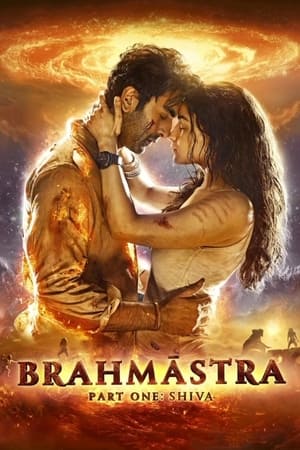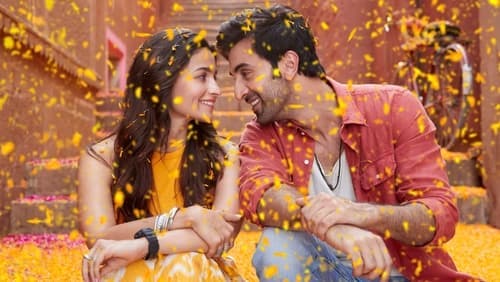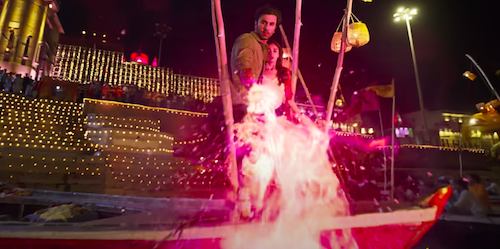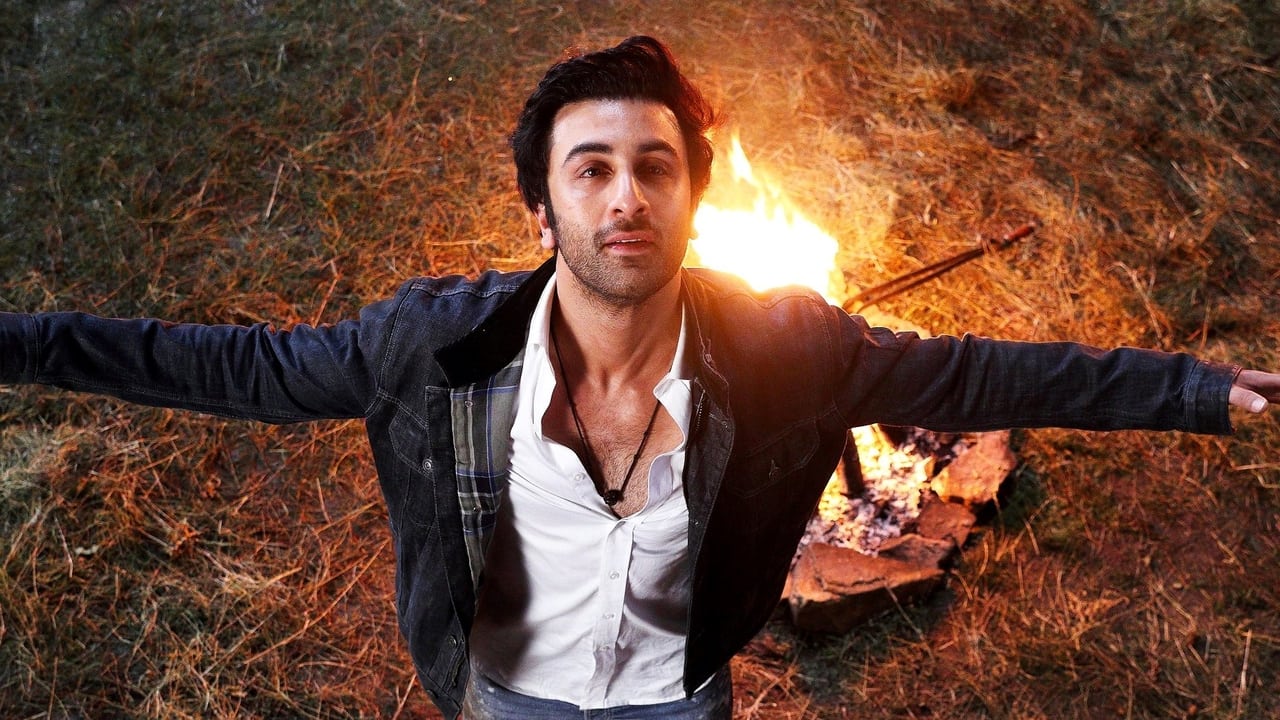
Sitting Shiva
For those who don't follow Indian cinema, Brahmāstra: Part One – Shiva is kind of a big deal. It's a film that has been in production for over five years (in the process becoming the most expensive Hindi language film ever produced), part of a promised fantasy-action trilogy that is intended to expand even further into an entire Astraverse. They even whipped up an Astraverse production logo to slap on the front of this one, promising more to come. Because that move has never blown up in anyone's face before.
Combining Western fantasy elements (Lord of the Rings and Harry Potter have been cited as influences, though there's a heavy dash of Avatar: The Last Airbender) with Indian mythology, the film follows a war brewing over an all-powerful ancient weapon known as the Brahmāstra. This weapon has been split into three pieces that are guarded by a secret cabal known as the Brahmānsh, who wield the other astras, all of which harness the powers of various natural energies like animals, fire, air, and water.
When the keepers of the pieces of the Brahmāstra start being targeted by the villainous Junoon (Mouni Roy) and her goons Zor (Saurav Gurjar) and Raftaar (Rohollah Ghazi), it becomes clear that she is attempting to reassemble the weapon and reawaken the godlike Brahmānsh defector who sought to wield it, a warrior known only as Dev. When poor DJ Shiva (Ranbir Kapoor) discovers that his longtime invulnerability to fire has begun to sprout into full-on pyrokinesis, all he wants to do is ignore it and keep chasing his crush Isha (Alia Bhatt) around town during Diwali. However, both Shiva and Isha are quickly dragged into the orbit of the Brahmānsh, as Shiva might be the only one who can prevent the destruction of the world.

That's the clearest I can make this plot, which is so overflowing with characters and incident that I had to double-check this was in fact the first film in the franchise. Although it's never presented particularly coherently (despite a rather lovely stylized animated sequence that introduces the backstory in the film's opening), it's so beholden to the Chosen One Discovers Secret Magical World tropes found in everything from Percy Jackson to The Matrix that you can put the pieces together quickly enough, even if non-Indians may want to Google some of the specific mythological details later on.
Unfortunately, Brahmāstra: Part One – Shiva doesn't find a way to assemble these tropes in a way that is any way satisfying, even if the cultural texture is different (which can sometimes be all a hackneyed story needs to find new life). The story runs Shiva through one of the most exhausting Campbellian hero's journeys this side of a college freshman's screenwriting elective, replete with twists that are pre-ordained from minute 5 of a 167-minute movie.
The action scenes also lean heavily on people making faces while they blast beams of energy at one another rather than actual stunt work, which would be more interesting if the design of the powers of the various astras didn't err on the side of illegible CGI mush every time. It's a subpar computer lightshow at every turn, improperly rendering every element, including the one that is central to Shiva's character. Unless in India fire really does look like a smear of strawberry-flavored KY jelly.

Typically, the things that have the potential to save a mediocre Bollywood film are the action sequences and the musical numbers. Brahmāstra: Part One – Shiva is sorely lacking in the action, which is its primary focus, but thankfully it does boast some solid musical moments, which range from "that was pretty" to "holy shit, let me catch my breath."
The holy shit one is the opening number "Dance Ka Bhoot", which doubles as an introduction to Shiva's life. In addition to featuring what feels like thousands of dancers, the choreography is stunning and confidently performed by Ranbir Kapoor, whose control over every individual part of his body is mind-boggling, all while continuously pumping charm and charisma directly into the lens. The porous relationship between action and dance in Bollywood cinema is admittedly on display here, as occasionally beneath the sludgy CGI you can glimpse something fun from him. But more than any other recent Bollywood star in my mind, he finds a way to perform through his body in smaller moments as well, rather than merely dance or fight scenes.
Shiva is an excellent achievement in character creation, endlessly confident and drawing you in while never feeling like he's on a pedestal and better than the everyman he's supposed to be. Unfortunately, the same can not be said of his screen partner. Bhatt (who also appeared in this year's smash hit Indian export RRR) does her best, but if the best way to describe Isha is a nothingburger, she's one made by Dagwood Bumstead. Literally, all she does in the entire movie is scream Shiva's name.
It's a tremendously inauspicious way to open a franchise that is meant to last a Tolkienian span of time. However, if the rest can be worked out (which I highly doubt it will, though stay tuned), Kapoor certainly is a screen presence that deserves a huge monument built around him.
Brennan Klein is a millennial who knows way more about 80's slasher movies than he has any right to. He's a former host of the Attack of the Queerwolf podcast and a current senior movie/TV news writer at Screen Rant. You can find his other reviews on his blog Popcorn Culture. Follow him on Twitter or Letterboxd, if you feel like it.
Combining Western fantasy elements (Lord of the Rings and Harry Potter have been cited as influences, though there's a heavy dash of Avatar: The Last Airbender) with Indian mythology, the film follows a war brewing over an all-powerful ancient weapon known as the Brahmāstra. This weapon has been split into three pieces that are guarded by a secret cabal known as the Brahmānsh, who wield the other astras, all of which harness the powers of various natural energies like animals, fire, air, and water.
When the keepers of the pieces of the Brahmāstra start being targeted by the villainous Junoon (Mouni Roy) and her goons Zor (Saurav Gurjar) and Raftaar (Rohollah Ghazi), it becomes clear that she is attempting to reassemble the weapon and reawaken the godlike Brahmānsh defector who sought to wield it, a warrior known only as Dev. When poor DJ Shiva (Ranbir Kapoor) discovers that his longtime invulnerability to fire has begun to sprout into full-on pyrokinesis, all he wants to do is ignore it and keep chasing his crush Isha (Alia Bhatt) around town during Diwali. However, both Shiva and Isha are quickly dragged into the orbit of the Brahmānsh, as Shiva might be the only one who can prevent the destruction of the world.

That's the clearest I can make this plot, which is so overflowing with characters and incident that I had to double-check this was in fact the first film in the franchise. Although it's never presented particularly coherently (despite a rather lovely stylized animated sequence that introduces the backstory in the film's opening), it's so beholden to the Chosen One Discovers Secret Magical World tropes found in everything from Percy Jackson to The Matrix that you can put the pieces together quickly enough, even if non-Indians may want to Google some of the specific mythological details later on.
Unfortunately, Brahmāstra: Part One – Shiva doesn't find a way to assemble these tropes in a way that is any way satisfying, even if the cultural texture is different (which can sometimes be all a hackneyed story needs to find new life). The story runs Shiva through one of the most exhausting Campbellian hero's journeys this side of a college freshman's screenwriting elective, replete with twists that are pre-ordained from minute 5 of a 167-minute movie.
The action scenes also lean heavily on people making faces while they blast beams of energy at one another rather than actual stunt work, which would be more interesting if the design of the powers of the various astras didn't err on the side of illegible CGI mush every time. It's a subpar computer lightshow at every turn, improperly rendering every element, including the one that is central to Shiva's character. Unless in India fire really does look like a smear of strawberry-flavored KY jelly.

Typically, the things that have the potential to save a mediocre Bollywood film are the action sequences and the musical numbers. Brahmāstra: Part One – Shiva is sorely lacking in the action, which is its primary focus, but thankfully it does boast some solid musical moments, which range from "that was pretty" to "holy shit, let me catch my breath."
The holy shit one is the opening number "Dance Ka Bhoot", which doubles as an introduction to Shiva's life. In addition to featuring what feels like thousands of dancers, the choreography is stunning and confidently performed by Ranbir Kapoor, whose control over every individual part of his body is mind-boggling, all while continuously pumping charm and charisma directly into the lens. The porous relationship between action and dance in Bollywood cinema is admittedly on display here, as occasionally beneath the sludgy CGI you can glimpse something fun from him. But more than any other recent Bollywood star in my mind, he finds a way to perform through his body in smaller moments as well, rather than merely dance or fight scenes.
Shiva is an excellent achievement in character creation, endlessly confident and drawing you in while never feeling like he's on a pedestal and better than the everyman he's supposed to be. Unfortunately, the same can not be said of his screen partner. Bhatt (who also appeared in this year's smash hit Indian export RRR) does her best, but if the best way to describe Isha is a nothingburger, she's one made by Dagwood Bumstead. Literally, all she does in the entire movie is scream Shiva's name.
It's a tremendously inauspicious way to open a franchise that is meant to last a Tolkienian span of time. However, if the rest can be worked out (which I highly doubt it will, though stay tuned), Kapoor certainly is a screen presence that deserves a huge monument built around him.
Brennan Klein is a millennial who knows way more about 80's slasher movies than he has any right to. He's a former host of the Attack of the Queerwolf podcast and a current senior movie/TV news writer at Screen Rant. You can find his other reviews on his blog Popcorn Culture. Follow him on Twitter or Letterboxd, if you feel like it.
Categories: indian cinema






